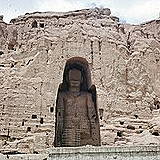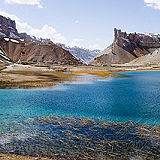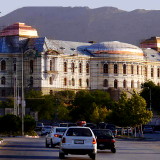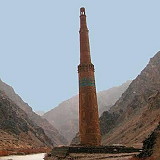
|
Buddha of Bamyan Bamyan, Afghanistan Last Updated: 05/15/2023 |
| The Buddha of Bamiyan refers to the monumental statues of Buddha that were located in the Bamyan Valley in central Afghanistan. The statues were carved into the cliffs of the valley and were considered one of the most significant cultural heritage sites in the world. | |
| Here is some information about the Buddha of Bamiyan: - Description: The Buddha of Bamiyan consisted of two large standing statues of Buddha, known as the "Eastern Buddha" and the "Western Buddha." The Eastern Buddha stood about 38 meters (125 feet) tall, while the Western Buddha was slightly smaller, standing at around 55 meters (180 feet) in height. The statues were carved out of the sandstone cliffs and featured intricate details and artistic craftsmanship. - History: The statues were believed to have been created in the 6th century CE during the period of the Kushan Empire, which had a significant Buddhist influence. The statues stood for over 1,500 years and became renowned symbols of Afghanistan's rich cultural and religious heritage. - Destruction: Tragically, the Buddha of Bamiyan statues were destroyed in 2001 by the Taliban, who considered them as idolatrous and against their interpretation of Islamic teachings. The Taliban used explosives and artillery to demolish the statues, resulting in their irreplaceable loss. - UNESCO World Heritage Site: The Buddha of Bamiyan, along with the surrounding archaeological and cultural landscape, was designated as a UNESCO World Heritage Site in 2003. The destruction of the statues prompted worldwide outrage and raised awareness about the importance of preserving cultural heritage. Efforts for Restoration: Since the destruction, there have been discussions and initiatives to restore the Buddha of Bamiyan. However, the restoration process poses significant challenges due to the complex nature of the statues and the ongoing security situation in the region. The Buddha of Bamiyan, despite its tragic loss, continues to hold cultural and historical significance and serves as a reminder of Afghanistan's rich heritage and the importance of preserving and respecting cultural treasures. | |
Wikipedia Facebook
Afghanistan » Afg
Place » Historical Place

|
Afghanistan Place » City Afghanistan is a landlocked country located in South Asia, bordered by Pakistan to the east and south, Iran to the west, Turkmenistan, Uzbekistan, and Tajikistan to the north, and China to the northeast. As of 2021, Afghanistan's population is 40.2 million, officially estimated to be 32.9 million. 91 views 💖 1 👍 0Afghanistan |

|
Darul Aman Palace Place » Historical Place Darul Aman Palac is a three-story-tall palace located in Darulaman, which about 16 kilometres (9.9 mi) south-west of the centre of Kabul, Afghanistan. In 2002, the Afghan government announced plans to rebuild the palace. The reconstruction project is being funded by the Japanese government and is expected to be completed in 2023. 417 views 💖 1 👍 0Kabul, Afghanista |

|
Minaret of Jam Place » Historical Place The Minaret of Jam is an ancient minaret located in Afghanistan's Ghor Province, in the western part of the country. The Minaret is situated in the remote and rugged Hari River valley, within the western part of the Hindu Kush mountain range. It is located approximately 215 kilometers (134 miles) southwest of the city of Herat. 301 views 💖 1 👍 0Afghanistan |
